This Sunday, June 10, is the Corrales (New Mexico) Garden Tour, which runs from 9 am to 4 pm. Come on out to the historic village for a great opportunity to see what can be grown in our dry desert landscape.
With that in mind, I thought I’d show you a few of the star performers in my little slice of hot, dry hell. Here in the Albuquerque metro area we get less than eight inches of rain a year (much less, lately), the summer temperatures rise into the 90s, with the occasional span of 100s; the winter lows can dip into the single digits (recently going as low as -10), with very little snow. Operative word is “dry.” The added complication in my yard is the soil, which is better described as beach sand.
In my garden, most of the plants below do so well that they are downright invasive, reseeding themselves everywhere. Probably not good plants for fussy gardeners who want crisply maintained beds and well-behaved plants, but great in a more rustic, relaxed setting.
Phlox or sand penstemon (Penstemon ambiguus) is a workhorse in sand. In fact, I’m not sure it would be happy in clay. It forms a mound, about 2 feet tall, and covers itself in pale pink flowers. Recently, I discover that it will readily rebloom if you shear off the first round of spent flowers. It can survive on rainwater alone and made it through our round of sub-zero temperatures in 2011. It hates being transplated, so I’d recommend starting it from seed. Otherwise a super tough, tough plant.
Wine cups (Callirhoe involucrata) is the plant to call on if you need to fill in a hot dry space quickly. On a drip irrigation system, it turns almost kudzu-like in my rock garden. I forgive its space-hog ways because it flowers nonstop for most of the summer, adding a touch of brilliant burgundy red to my mostly yellow and orange flower palette.
Mexican Hats or Prairie Coneflowers (Ratibida columnifera) come in a variety of colors, from red to yellow. They bloom more with a little supplemental watering, but once established will survive on rainwater alone. These are the old-reliables in my naturalized wildflower garden (not on drip system). The only problem I’ve had with them is their tendency to seed in the brick pathways. I think it’s charming; my husband, who wants a tidier yard, not so much.
The name says it all, ladies. Chocolate Flower (Berlandiera lyrata). All summer long, thanks to this fragrant bloomer, my yard smells like chocolate in the mornings. This is another plant that once established, will survive on neglect, but a little extra water means extra blooms and more chocolatey goodness. Plant next to mint for, what else, chocolate mint aromas!
Of all my experiments with salvias, May Night (Salvia memorosa), is the most successful. It’s long lived; seeds itself gently, and reblooms when deadheaded. Even in my yard, I sometimes have problems with mold (I know, go figure), but this variety seems to be largely immune. This is definitely a bee friendly flower, attracting more buzzing honey bees than even my lavender.
And finally, I’ve got two varieties of Catmint in my yard, but lost track of which is which. I think one variety is Nepeta faassenii. I’m not sure it really matters, because catmint (and catnip), like other aromatic herbs (rosemary, thyme) do well in the hot desert–on a drip irrigation system. Long lived, these form a gray-green mass and have light purple blooms. Will rebloom if deadheaded.
There are other stars in my garden, but these are the ones in bloom, now in early June. Because I have tendency to steal borrow plants that grow along the nearby irrigation ditch (if they’ll grow there, they’ll grow anywhere), some of my best plants are unidentified. Like this little wild primrose, an annual that comes up from seed every year.

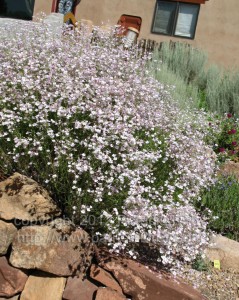
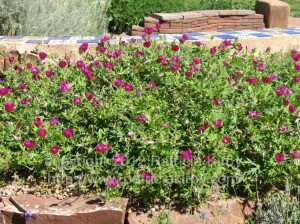
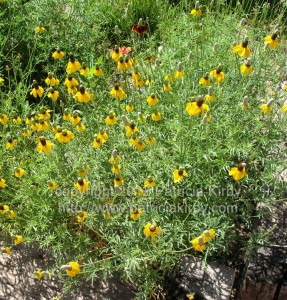
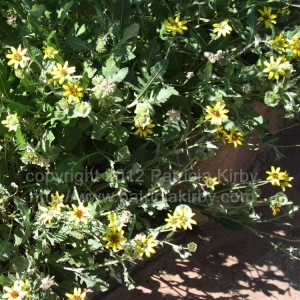
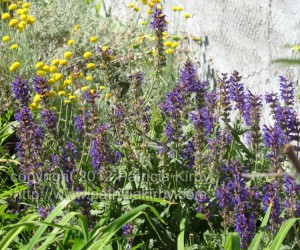
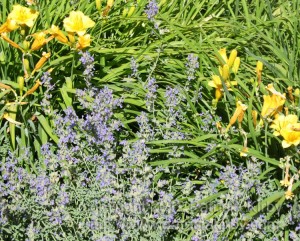
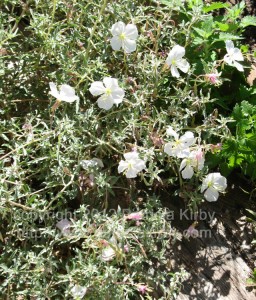


For the ones that you do irrigate, how much water do you give them and how often?
Beautiful post! Thank you! I may have to try the wine cups.
@Kristin. I’d actually have to check with my, ahem, irrigation manager, aka, the hubby, to give you a specific gallons/min/hour number. All the plants show here get the slowest/lowest drippers, unlike the roses, that get a much higher volume. When it starts to gets this hot, the system is runs for about thirty minutes, every other day, early morning. I’ve got like five zones, which run on different days. I use pea gravel mulch, because bark and other organic-y mulches promote disease in xeric plants. By fall I taper off to every three days, and then once a week.